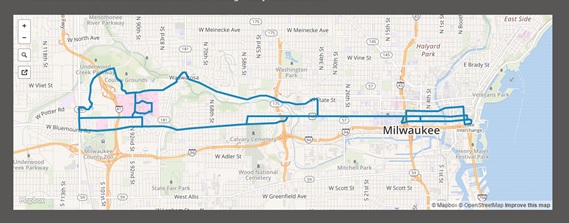After we have spent years calling for a better balance in our transportation spending, someone is listening. The fight continues within the Wisconsin Department of Transportation (WisDOT) to recognize the ability for transit to be a cheaper, better option to provide access for all to get to the jobs, healthcare and other services, and other needs. Fortunately, Milwaukee County, the City of Milwaukee, and the City of Wauwatosa are moving forward on a Bus Rapid Transit (BRT) project.
What is BRT?
BRT is a usually a specialized bus system that quickly moves people from one place to another. In practice, it is more like a train because many systems have bus-only lanes (so the bus can’t get stuck in traffic), multiple doors, separate ticketing processes, and other designs to get people on and off the bus as quickly as possible, and other reduced bus stops. When connected with other transit systems, BRT can be the piece to an efficient, fast transportation system that can keep a community thriving.
BRT has made a huge different in some areas. In Cleveland, the HealthLine began operation in 2008. A year later, ridership had already expanded 47 percent and has generated $5.8 billion in development—this equates to more than $114 returned for every dollar invested in the project.
In Kansas City, Missouri, the MAX BRT line in the main street connects to 150,000 jobs and thousands of other conveniences, with a 20% reduction in travel time. One study found that the project yielded a 300% return on investment. These kinds of results are found all over. In San Antonio, the combination of the street car and BRT has transformed the transportation system in the community and travel times have been reduced by 20%. Jacksonville’s new system is already showing results and growing.
Milwaukee’s BRT System
The East-West BRT project will similarly connect people to jobs, stir economic development, and transform the city. The system will be a fast, specialized, quality bus-based transit system. Specifics of the project are still in the planning stages.
The BRT project is still being finalized, using public input. For example, Wisconsin Avenue has been removed from consideration for a number of reasons. Here is a map of the proposal:
Regardless of the specifics, the BRT plan will have huge benefits to Milwaukee and the surrounding communities.
Reduced Congestion:
Increased ridership will mean fewer drivers on the road. This will reduce road congestion and road related accidents. The number of single occupant vehicles on Bluemound Rd could be reduced if some of those drivers instead took the bus, thereby making it safer for pedestrians to cross the street. The bus drivers that work for BRT systems are professionally trained unlike the citizens driving on the road, increasing safety.
Without BRT, congestion will become worse. According the Final Environmental Impact Statement (EIS) for the Zoo Interchange reconstruction, north-bound traffic on Glenview Ave (84th St.) exiting off of I-94 is expected to increase by 1,000 additional vehicles per day upon project completion. Most of those vehicles will be turning east or west on Bluemound Rd.
Increased Job Growth and Economic Development:
Bus Rapid Transit (BRT) is necessary for job growth in Milwaukee. BRT would connect passengers to the region’s two largest job centers, creating a high-quality transit spine across the county from the Lakefront Gateway in downtown Milwaukee (81,000 jobs), Near West Side (30,000 jobs) to the Milwaukee Regional Medical Center in Wauwatosa (16,000 jobs)—a dense corridor of employers, healthcare, destinations, and a diversity of neighborhoods. In total, BRT would be providing access to around 127,000 new jobs. BRT would provide real access to jobs—trip times similar to driving at peak times.
BRT in other places has spurred $100 million - $5.7 Billion in walkable development and more than 13,000 jobs, enhancing the efficiency, character and vibrancy of neighborhoods along the route. It is necessary that we increase, instead of decrease, our funding in public transit.
Increased Accessibility:
This is the only option for many citizens who cannot drive or cannot afford to drive. By allowing our money to go into highway expansion and reconstruction, we are eliminating the access many citizens have to places outside of their immediate neighborhood. It is essential that federal funding is being used to aid as many people as possible. In other cities, BRT has seen an increase of ridership by 25-50%. The 25-50% increase of public transit passengers are not people who previously did not need a public transit for transportation, but people whose needs could not be met by the current public transit system available for them.
We cannot let ineffective transit systems be the reason why our very own citizens do not have access to good jobs, different educational opportunities, and beneficial experiences. It is our duty to make sure that every citizen has equal opportunities and the first step towards this goal is to provide increased access to new opportunities through Bus Rapid Transit.
Click here to write your Alderman and ask them to support the project.
Want to do more? Attend the hearing this Wednesday:
East-West Bus Rapid Transit Feasibility Study
Public Open House
May 18, 2016 5:00-7:00 p.m.
Marquette University Campus
Alumni Memorial Union
3rd Floor Ballroom
1442 W. Wisconsin Avenue
Milwaukee, WI 53233
MCTS bus routes serving Marquette University include GoldLine, BlueLine, Routes 14, 23, 30, and 30X.
Learn more about the hearing here.
